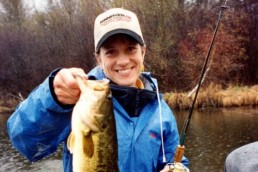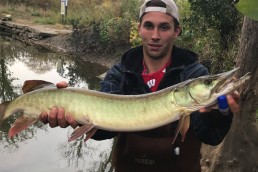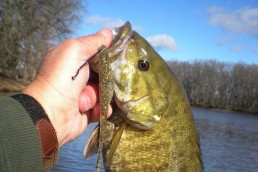SHARE THIS POST
Why do I make the claim that trolling catches more fish? It’s easy to understand. One thing is that your bait offering is presented to a fish longer and to more of them. Trolling allows your bait or lure to be presented in a more natural fashion. The fish are able to size your bait up by eyeing it and testing its reaction to any bump-and-stun they might perform on it.
Gamefish are apt to perform many antics before directly engaging your offering. The sudden strike, when casting and retrieving, is only performed 10 to 15 percent of the time as a lure is presented.
I’ve disclosed the bump-and-stun technique in previous issues, and walleyes were seen doing this on underwater video numerous times as we fished these suspended fish. But during this technique unfolding, have you ever actually foul-hooked a walleye, bass or pike? I always thought it was due to poor “striking” eyesight. Now I realize it happened when these fish were in fact performing the bump-and-stun technique. Therefore, when testing any new lure I insist that all line Gapen releases to the public be tested at least three years before releasing it into the market. This testing phase can show us the wrong and right ways of presenting the new lure.
We have written about the fact that all species have the ability to rotate their eyeballs to size up their prey before striking. Pike and muskies have the best ability to look over their prey before engaging it. Walleyes, bass and panfish have a similar talent, but fail to use it as much as the larger species.
With “Bobber” Anne’s underwater video running, we discovered the favorite attack mode used by crappies is to position themselves on an equal level with minnows then attack them straight on. Then, after engaging, they rise up as the minnow is swallowed. This attack mode was keenly noted when grandpa used a turkey quill as a float. Instead of pulling the quill under as a crappie engaged the minnow, the quill rose up and just lay flat on surface. This was a signal to set the hook. Once a quill float begins to run off or run deep, engaging the crappie is often missed.
Why else does this happen? Setting the hook as a float lies flat on a surface can give you a 99 percent hook-up rate. But if you wait until it disappears, you then stand only a 60 to 70 percent chance of a hook-up. At this point, the crappie has detected the “unnatural” feel of the minnow and hook and is attempting to dislodge it from its mouth as it swims off.
If you’re using a red and white, round plastic bobber, the chances of a crappie hooking up drops to 50 percent as the float is pulled below the surface. This is where using European-style floats can work. These are made of balsa, and are more sensitive and can detect the first “feel” as a panfish touches your minnow or jig.
Are you enjoying this post?
You can be among the first to get the latest info on where to go, what to use and how to use it!
My experience has proven that any jig made with a silver Mylar tail will entice a fish much better than any other colored material. In the North, 1/32 ounce seems to be a preferred weight/size. Why I’m not sure. Maybe it’s because many of the large-mouthed species can be caught on 1/16 and 1/8 ounce. If you don’t believe me, next time you boat a hand-sized crappie, look at its mouth opening. It’s huge compared to the rest of its body.
Let’s talk about late-summer crappie structure. A lake you’re fishing may have a stand of cabbage weed, an area where you normally fish for bass. Cabbage generally grows in 10 to 14 feet of water. Take your cue from the cabbage. Position your boat anywhere from 50 to 100 feet out from the cabbage and then look for a large mass of fish (big blob on electronics) holding at 12 to 16 feet below the surface and over 20 to 24 feet of water. Remember, this is a daytime test. From this spot they’ll slowly migrate in toward the cabbage late in the day, where there are minnows holding in the cabbage as the fish’s target. Small crappies can be found during this time slot. They’ve worked into the shallow, weedy bays where they’re easily caught on flies as they break the surface feeding with the bluegills on tiny fish fry to hatching mayflies to weed-covered insects.
In this scenario, flies such as a Flick Fly, small popping bugs, nymph patterns or a number 10 or 8 streamer, will work. If you use a float like the one in one of the accompanying photos, a 1/64- or 1/32-ounce Gapen Freshwater Shrimp Jig will catch both the crappies and bluegills.
Throughout my years of bluegill angling from Minnesota to Florida, I’ve found that black is the best color to entice bluegills. Black flies and 1/64-ounce jigs will do nicely in spring, summer or fall. And if you’re seeking only bluegills, a scented tip on your bait can increase your catch rate. However, when it comes to crappies, scent isn’t necessary. In the spring, a Mylar-type jig will catch just as many of this species as the same jig tipped with a crappie minnow. It seems that crappies, with their huge mouths, are less affected by scent at this time. However, as July rolls on, a scent tip on your artificial crappie bait will increase your catch rate.
As summer waters heat up even more this month, to the 64-degree mark, increase the amount of scented baits used by fishing with nightcrawlers and garden earthworms. Worms contain the same amino acids as crawfish. And this 64-degree mark is also the point at which insect life begins to hatch from the muddy lake or river bottom. Most fish, especially panfish, feed heavily on this nymph life. These also smell a lot like worms. So, if you select worms to utilize scent versus using minnows, you’ll likely have the proper scenting device to tip your baits with.
Finally, your kitchen refrigerator is an excellent storage unit for storing leftover live baits. Leeches that can be bought by the pound can be kept lively all summer by placing them in a Thermos or container and adding ice cubes weekly. Icy water causes the leeches to go dormant, just as they do in the ice-cold waters of winter.
If you use a flip-top dispenser or Thermos, it will do more. The leeches are dispensed one at a time through the spout if there is one attached. And, by having a small can of sand in the boat, you can drop the leech into it, coat it, and easily and quickly put it on the hook.
MWO
SHARE THIS POST
Did you enjoy this post?
You can be among the first to get the latest info on where to go, what to use and how to use it!
Dan Gapen
Considered one of the world’s leading river anglers, Dan Gapen, Sr. has shared his knowledge with MidWest Outdoors readers and viewers for more than 40 years. He is a member of all three Fishing Halls of Fame—International, National Freshwater, and Minnesota. He has an immense grasp of the world’s fisheries. He may be contacted at 877-623-2099.
@TheGapenCompany.



